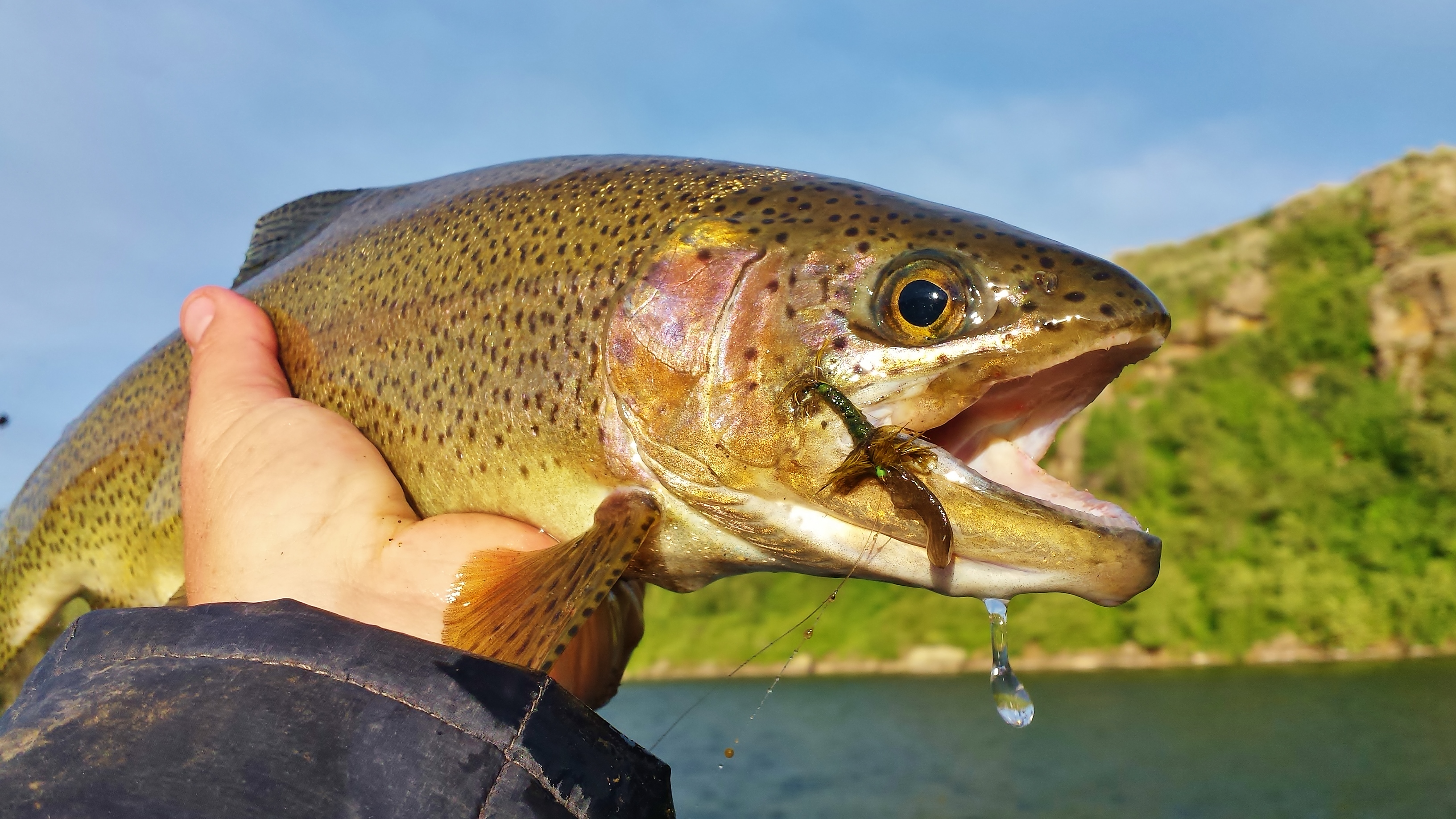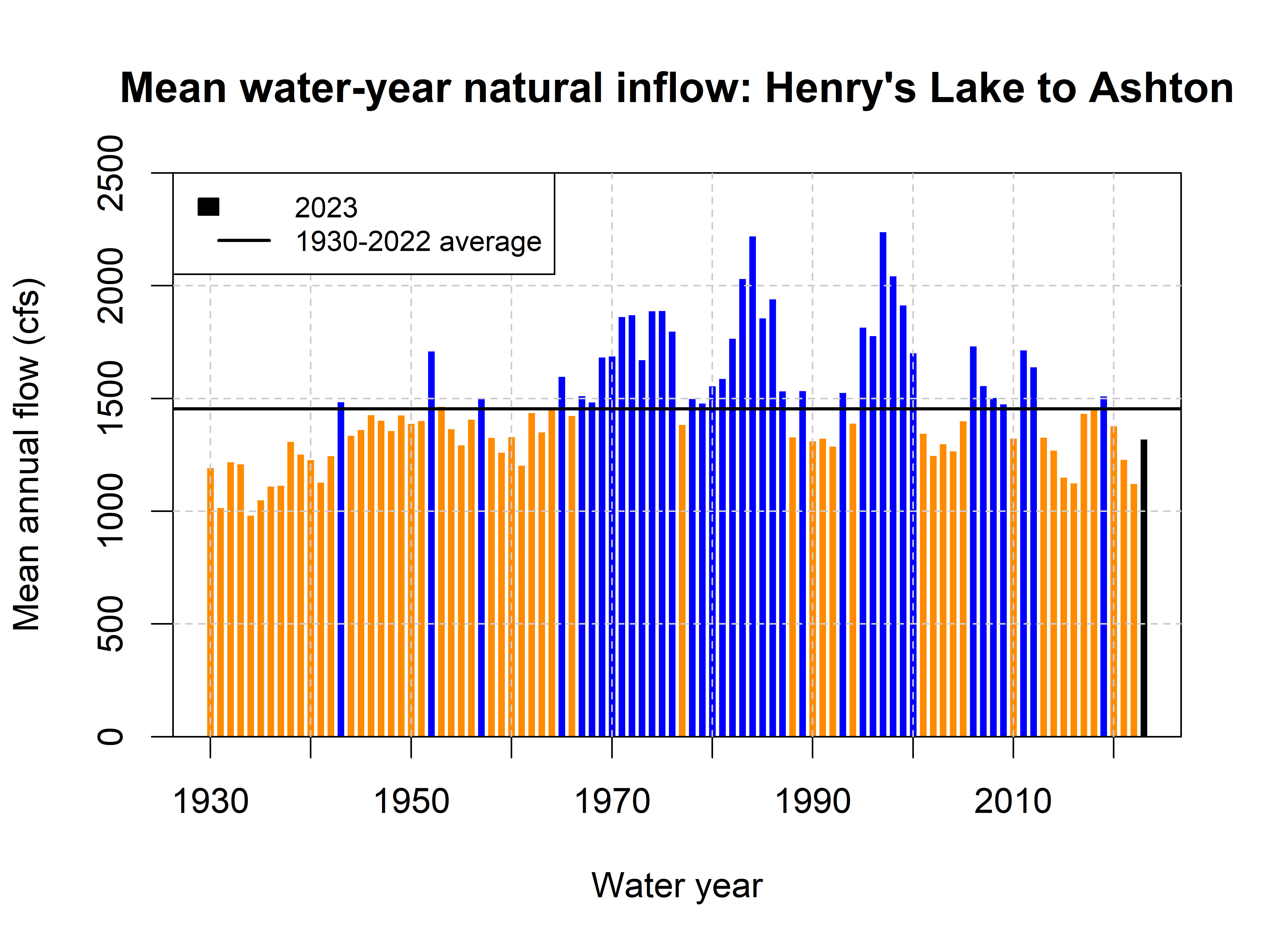The Henry’s Fork, a tributary of the Snake River in southeastern Idaho, is a premiere, globally recognized flyfishing destination. The river also carries water to farms that irrigate high-value crops. As climate change alters precipitation patterns and intensifies warming and extreme events in Idaho, severe drought is likely to occur more often, affecting farms and rivers throughout the state. The Henry's Fork Foundation, Friends of the Teton River, Trout Unlimited, and The Nature Conservancy have partnered on a program that benefits agriculture and fish by reducing irrigation water use and improving farm resilience and fish habitat.
Reading Time | 6 minutes
Management Goals | Change crop rotations, irrigation methods, and delivery precision to reduce water use and improve fish habitat above, within, and below Island Park Reservoir.
Audience | Land managers, fishermen, farmers, ranchers, nonprofits
Project Leads & Contact Info | Daniel Wilcox, daniel@henrysfork.org; Brandon Hoffner, bhoffner@henrysfork.org
Project Area | Henry’s Fork of the Snake River, southeastern Idaho
Organizations | Henry’s Fork Foundation, Friends of the Teton River, The Nature Conservancy, Trout Unlimited
A changing climate is affecting farms and fish in southern Idaho

Drought is already affecting agriculture and fish on the Henry’s Fork. From 2013 to 2016, the river experienced its driest four-year sequence since the 1930s, and in 2022, the upper Henry’s Fork sub-watershed saw its driest water year since 1937. Drought puts pressure on farmers and increases the demand for irrigation water. In addition, rising temperatures and changing precipitation patterns contribute to lower snowpacks, earlier snowmelt, and rapid water withdrawal from Island Park Reservoir. These factors have resulted in higher stream temperatures, decreased dissolved oxygen concentrations, and lower late-season river flows, all of which degrade the health and habitat of the river’s salmon and trout. As farmers withdraw more water during drought, less water is available to maintain fish habitat throughout the year. Without adequate habitat for their entire life cycle, fish populations decline and poor fishing conditions can persist for years following a drought.
As the impacts of climate change intensify, increased water demands for crop irrigation and fish habitat are likely to exacerbate conflicts. Farmers, fishermen, land managers, and water managers are considering how to maintain an adequate water supply for multiple uses in a changing climate.
What are the goals of the Farms and Fish Program?
In 2018, the Upper Snake River Collaborative formed to develop strategies to meet the pace and scale of changes to the Henry’s Fork water supply. The Farms and Fish Program emerged from this collaborative and focused on working with individual farmers to improve fish habitat while strengthening agricultural production.
The primary goal of the Farms and Fish project is to help irrigators balance crop rotations and production with the water supply of Island Park Reservoir and the Henry’s Fork River. In this way, the water supply is sustained year-round and can support irrigation delivery and fish habitat. The Farms and Fish Program has no authority to change water usage. Rather, the Program brings farmers and fishermen together to collaborate on water management. When farmers implement water conservation practices on their land, the conserved water can be stored in the reservoir and released during low water to maintain healthy fish populations in the river. When these practices are paired with water system modeling, they can produce more precise water delivery schedules that benefit farms and fish. The Farms and Fish Program works to meet state water management goals, increase economic returns for farms, and reduce demand for water throughout the watershed.
How is the Upper Snake River Collaborative helping to reduce water use?
The Upper Snake River Collaborative cannot mandate water usage or flow level out of Island Park Reservoir. Instead, they have negotiated with farmers to implement a number of actions to reduce water use and improve soil health and water quality. Incentives used to support farmers who adopt practices are largely funded by anglers who benefit from the additional water left in the river for fish habitat.
The Farms and Fish Program has worked to help farmers implement the following practices:
- Leasing farmland to defer irrigation. Farmers lease their land, either leaving it fallow or grazing livestock on cover crops, to reduce irrigation demand. Compared to a four-year or seven-year crop rotation (typical for the Upper Snake River Plain in southeastern Idaho), the Collaborative pays farmers to forgo irrigation once every four years.
- Improving soil health. The Farms and Fish Program encourages farmers to monitor soil moisture and use soil health practices such as cover cropping, no-till, and interseeding where appropriate. These practices can build soil organic matter, improve water-holding capacity, and reduce soil erosion. Even a 1% increase of soil organic matter can result in a gain of as much as 25,000 gallons of soil water per acre.
- Converting to different crops. Farmers can grow some of their crops in different seasons (e.g., winter-wheat conversion from spring-planted grain), plant cover crops, or plant crops that require less water. This can lead to less water use overall.
- Utilizing agricultural technology. Within the region, producers are integrating advanced agricultural technologies like soil moisture monitors, irrigation modeling and scheduling, satellite imagery, and low-elevation sprinkler applications to balance crop growth and water use. These tools help producers adjust irrigation precisely on the individual farm-field level, monitor crop health, enhance crop productivity, and minimize over-watering, which can reduce water use.
The Farms and Fish Program is also partnering with the Conant Creek Canal Company and Fremont-Madison Irrigation District to improve the existing irrigation infrastructure that diverts water from Conant Creek, a tributary to the Fall River and Henry’s Fork. The project involves lining the canal with plastic to eliminate seepage water loss. Some of the goals of this project are to store an additional 2,000 acre-feet of water per year in Island Park Reservoir (1.5% of reservoir capacity), and to improve aquatic habitat, connectivity, and ecological resilience for cold-water fish species in Conant Creek, Fall River, and the Henry’s Fork River, especially during the summer.
How does the Farms and Fish Program find participating farmers?
Most of the farmers who participate in the Farms and Fish Program already maintained a relationship with the Collaborative or its members. Because of these long-standing relationships, the Upper Snake River Collaborative can craft custom arrangements that suit each farmer’s needs. During the 2022-2023 crop season, 10–12 producers enrolled 4,500 acres of farmland in the Program in the Ashton area, and an additional 7-8 producers in Teton Valley enrolled 1,200 acres. There are plans to expand.
Project outcomes to date
In 2022, the Farms and Fish Program conserved 2,300 acre-feet of Island Park Reservoir storage through various agreements. Reservoir carryover levels (the amount of water that remains in the reservoir from year to year) have also improved by 25,000 acre-feet annually from 2018-2022. Along with efforts led by the Farms and Fish Program, fewer farmers diverting water during drought conditions contributed to these improvements. More water stored in the reservoir means better trout habitat throughout the year on the Henry’s Fork. These programs have also increased winter outflow (the amount of water that flows out of a reservoir in winter) from Island Park Dam by an average of 116 cubic feet per second since 2018, an increase of 44%. Because higher winter outflows are correlated with higher trout recruitment, winter outflow is an important factor in fish population dynamics. Downstream of Island Park Reservoir, trout recruitment has already improved by 20% compared to levels before 2018.
The importance of baseline data

Before the Program formed, the Henry’s Fork Foundation had years of baseline data, including water quality monitoring, stream temperatures and more. Executive director Brandon Hoffner notes that “Baseline data is essential to figuring out what you really need to make specific management adjustments on your river.” An organization interested in undertaking a similar project can begin with strong baseline data and identify priorities from there. Hoffner emphasizes that building trust with local communities has been essential to the success of the Farms and Fish Program. While solid baseline data builds trust, he notes that it is equally important to build new relationships and maintain long-term relationships with farmers.
Some of the other tools informed by baseline data and used to assess and predict the impacts of climate change on the Henry’s Fork include:
- Models that predict water levels and agricultural water needs in a given year, created by Henry’s Fork Foundation scientist Dr. Rob Van Kirk.
- Streamflow measurements conducted by Henry’s Fork Foundation staff. These measurements provide more data to build into the models.
- PhD students working on upper river habitat, and optimization of habitat flows on the lower Henry’s Fork.
Uniting for a common cause
By bringing farmers and fishermen together, the Upper Snake River Collaborative Farms and Fish Program has helped to save water, improve fish habitat, and make farms more productive along the Henry's Fork River. This program has also helped farmers and fishermen work together to make southern Idaho more prepared for climate change. As climate change continues to affect the Northwest, it is important for government agencies, landowners, recreationalists, and others to work together to adapt. The Farms and Fish Program shows how seemingly opposing groups-farmers and fishermen-can come together to achieve a common goal of climate resilience.
Funding
- U.S Bureau of Reclamation WaterSMART Water and Energy Efficiency Grant, $1,095,000.
- Idaho Department of Water Resources grant, $500,000.
- National Fish Habitat Partnership funding
Additional Information
Henry’s Fork Foundation website provides project and contact information.The Henry’s Fork Basin Study: Final Report from the State of Idaho Water Resource Board and the U.S. Bureau of Reclamation.




